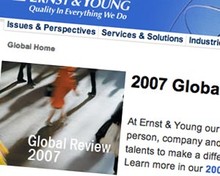
The Media and Entertainment… by numbers report looked at the potential wealth that could be created by newspapers online and concluded the CPM (cost per thousand impressions) ad model they commonly used wasn't generating 'the necessary growth'.
The report suggested that if top newspaper websites generated the same revenue per UK unique user in 2007 as Google, which uses a Cost per Click (CPC) ad model, they could have expected ad revenues of between £120 million and £250 million each from their domestic traffic.
Instead the report suggested that many nationals total online revenues barely reaching 'one fifth of this amount'.
Ernst & Young estimated that top newspaper websites generated £15m to £20m in ad revenue in 2007, compared to Google's UK ad revenue of £1.26bn for the same year.
"The online revenue gap between nationals and Google is also evident if we consider that the latter could have generated £2.40 per UK unique user per month from its websites in 2007, compared to top newspaper websites' £0.10 to £0.13," said Luca Mastrodonato, media and entertainment analyst, Ernst & Young.
"This gap is an opportunity for newspapers as it shows that monetising online services in the UK is possible. But to do so, newspapers need to move away from the volume based CPM model towards more interactive ad models such as CPC (cost-per-click) or CPL (cost-per-lead).
"CPM has the characteristics of display adverts in traditional media, which sell on reach rather than interaction. However, with many online users spending time interacting on social networks and the like, by circulating millions of untargeted adverts publishers may be missing out on opportunities to increase their ad revenue to the advantage of online specialists."
The report went on to criticise newspapers CD and other give-aways as having only 'a short-term effect' and suggested that despite spending time and money upgrading the look and feel of newspapers, publishers were still struggling to attract young readers to their paid-for titles.
Free daily newsletter
If you like our news and feature articles, you can sign up to receive our free daily (Mon-Fri) email newsletter (mobile friendly).
Related articles
- Post-Perugia thoughts: what went wrong between big tech and the news?
- Audiences, AI and audio apps: five talking points from Perugia
- Protecting independent journalism, with Lexie Kirkconnell-Kawana of IMPRESS
- Why Australia's bid to make big tech pay for news failed: views from an indie publisher
- Five key takeaways from the UK select committee on the future of news









